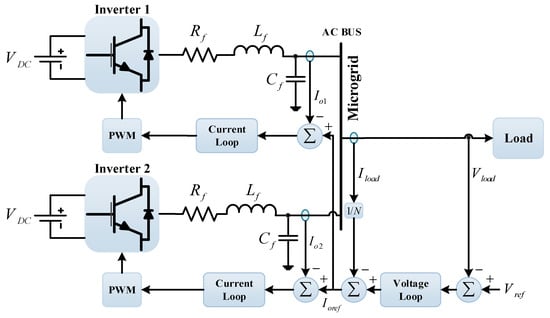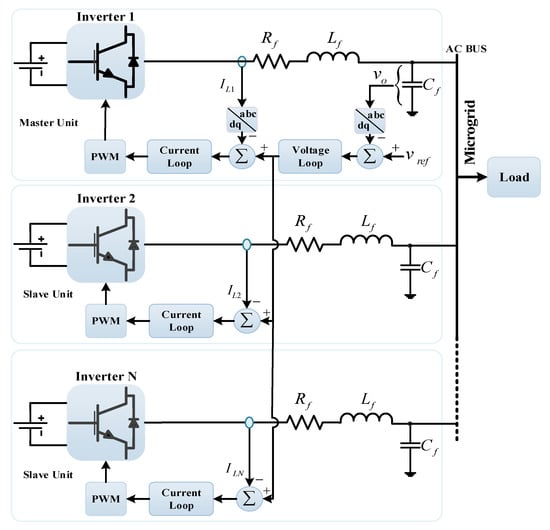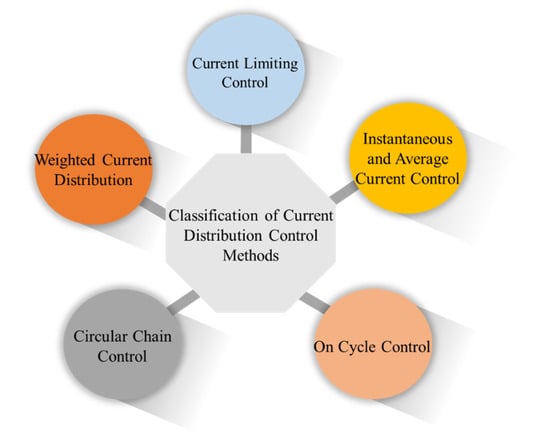Your browser does not fully support modern features. Please upgrade for a smoother experience.
Please note this is an old version of this entry, which may differ significantly from the current revision.
Subjects:
Engineering, Electrical & Electronic
The communication-based control methods require a power management platform or supervisory control and data acquisition (SCADA) operation. These control methods are employed to provide power-sharing and voltage control, and their main advantage is eliminating the requirement for a secondary controller. The supervisory control receives information from all inverters and tries to maintain a balance in power-sharing between the inverters.
- AC microgrids
- advanced controllers
- autonomous operation
- frequency control
1. Introduction
Electric power generation in conventional power systems includes serious issues such as high energy losses in power generation and transmission, high generation costs, carbon emissions, environmental concerns, and high investment costs for grid expansion [1]. Thus, distributed generation units (DGs) that include renewable energy resources (RES) (photovoltaics, wind turbines, hydrogen) are suitable alternatives and promising solutions for overcoming the stated challenges [2]. To make the DGs’ operation compatible with the grid and maximize the benefits of DGs integration in productivity, the economy, energy efficiency, and the environment, researchers have considered the concept of microgrids (MG) [3]. An MG is a small-scale local grid capable of operating in both a grid-connected mode and islanded mode (isolated from the grid) and is capable of managing the transitions between these two modes.
The main characteristic of the MG is the capability for autonomous operation in the islanded mode, which improves the reliability of the local grid and can increase the resiliency of the power system [4,5]. The main variables utilized to control the performance of an MG are the voltage, frequency, and active and reactive power [6,7]. In the connected mode, the grid imposes the voltage and frequency, and the MG supplies the power deficit from the grid and trades the excess power generated in the MG with the grid [8]. In the islanded mode, the lack of access to the (stiff) grid has led the MG to perform autonomous voltage and frequency control [9]; moreover, power-sharing among DG units (for load tracking) should be implemented to maintain the production–consumption balance [10].
The frequency and voltage should be set autonomously in the islanded MG; however, power electronics-based inverters that interface DG units to the (micro) grid are used, which requires new paradigms in voltage and frequency regulations [11]. Notably, employing effective voltage and frequency regulation methods for establishing power-sharing among parallel grid-forming (GFM) inverters is the most important problem. Since there is a compromise between voltage/frequency regulation and power-sharing that imposes power quality issues and stability challenges, it is vital to ensure the MG’s dynamic stability and the desired performance while realizing power-sharing through voltage/frequency regulation.
2. Concentrated Control
This control scheme cannot operate without a centralized controller to acquire the synchronization signals, as shown in Figure 2. The load current can be shared when the phase-locked loop (PLL) is used to ensure synchronization between the grid-feeding (GFD) voltage source converter and the grid [33]. This reference current needs to be assigned to all parallel-connected inverters by a high bandwidth communication link (HBWCL).

Figure 2. Control schematic of the concentrated/centralized communication-based control [33].
In [15,22,35,47,48,49,50], a communication-based control technique is presented so that the current sharing in the transient and steady state can be maintained using this technique; however, the centralized current controller cannot manage harmonics and prevent circulating currents among parallel inverters. To address this problem, high bandwidth communication is necessary; while it reduces reliability and expandability, it provides stable power-sharing in transient and sustained modes and constant voltage and frequency regulation [30,51].
3. Master–Slave Method
In the master–slave control strategy, one inverter acts as a master and the remaining inverters act as slaves. The master–slave control strategy diagram is illustrated in Figure 3. As suggested in [21,41,52], this technique is mainly based on the oscillating master/dedicated master. In the dedicated master, one inverter works in the voltage control mode and other inverters run in the current control mode. The master unit specifies the reference current for the slave units so that the slave unit follows the reference current. Yet, if the dedicated master suffers a single point of failure, it will significantly affect the stability of the whole system. In [21], the master oscillating technique is suggested to overcome this weakness. The master depends on the maximum inverter active power flow. This proposed technique improves reliability and increases the power-sharing accuracy, but it may lead to synchronization errors [53].

Figure 3. The control structure of the master–slave control [33].
4. Current Distribution Control
Communication-based current distribution control strategies are employed to accomplish voltage regulation and power-sharing among parallel inverters, where power quality is a concern [16,49,54]. These techniques do not require a central control unit while keeping the output voltage amplitude and frequency close to the nominal values [35]. Hence, these control strategies can limit system reliability, flexibility, and scalability, as well as increase system costs due to the expensive and vulnerable communication link [33]. This technique can be further classified as depicted in Figure 4. It can be categorized into current limiting, average current sharing, circular chain control instantaneous current control, one cycle control, and weighted current distribution control techniques.

Figure 4. Classification of the communication-based current distribution control strategy.
- (1)
- (2)
-
The average and instantaneous current control techniques are based on inter-unit communication, in contrast to the master–slave control method. This technique requires reference synchronization for the voltage and current at the point of common coupling (PCC) to have better current sharing and voltage regulation. Figure 5 shows the structure of this control method. Yet, this technique reduces the flexibility and reliability of the system [16].
- (3)
-
The one-cycle control method combines a vector and bipolar operation with an extra simple communication link among the parallel inverters. Thus, the circulating current among parallel inverters can be reduced. This control technique has advantages, such as constant switching frequency, no reference calculation, simple system wiring, and lack of need for multipliers, while providing more flexibility [4,57].
- (4)
-
The circular chain control method, which is also known as the 3C method, is illustrated in Figure 6. In this technique, each unit is connected in a circular configuration that uses internal current control to track the inductor current of consecutive parallel inverter units for achieving equal current distribution among the parallel inverters [31,44].
- (5)
-
The weighting current distribution control technique has been proposed to achieve current sharing among inverters with different power ratings. It gets a weighted output current by simply adding a simple circuit for each inverter. In this technique, each inverter has current and voltage controllers for a fast dynamic response, stability, and an improved weighted current controller for achieving current sharing among the inverters [45,58].

Figure 5. Average and instantaneous current control [35].

Figure 6. Circular chain communication-based control strategy [44].
4. Summary of Communication-Based Control Strategies
The merits and demerits of communication-based parallel inverter control techniques are summarized in Table 1.
Table 1. The merits and demerits of communication-based parallel inverter control techniques.
| Control Techniques | Merits | Demerits |
|---|---|---|
| Concentrated control |
|
|
| Master–slave control |
|
|
| Current Distribution Control |
|
|
This entry is adapted from the peer-reviewed paper 10.3390/en15228580
This entry is offline, you can click here to edit this entry!
